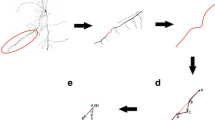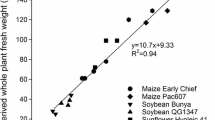Abstract
Calibration of minirhizotron data against root length density (RLD) was carried out in a field trial where three drip irrigation depths: surface (R0) and subsurface, 0.20 m (RI) and 0.40 m depth (RII) and two processing tomato cultivars: `Brigade' (CI) and `H3044' (CII) were imposed. For each treatment three minirhizotron tubes were located at 10, 37.5 and 75 cm of the way from one plant row to the next. Roots intersecting the minirizotrons walls were expressed as root length intensity (L a) and number of roots per unit of minirhizotron wall area (N ra). Root length density (RLD) was calculated from core samples taken for each minirhizotron tube at two locations: near the top of the minirhizotron (BI) and 15 cm apart from it, facing the minirhizotron wall opposite the plant row (BII). Minirhizotron data were regressed against RLD obtained at BI and BII and with their respective means. The results show that for all the situations studied, better correlations were obtained when RLD was regressed with L a than with N ra. Also was evident that the relationship between L a and RLD was strongly influenced by the location of soil coring. RLD was correlated with L a trough linear and cubic equations, having the last ones higher determination coefficients. For instance at 10 cm from the plant row when values from the top layer (0–40 cm) were analysed separately, L a was significantly regressed with RLD measured at BII and described by the equations: RLD = 0.5448 + 0.0071 L a (R 2 = 0.51) and RLD = 0.4823 + 0.0074L a + 8×10−5 L a 2 − 5×10−7 L a 3 (R 2 = 0.61). Under the 40 cm depth the highest coefficients of determination for the linear and cubic equations were respectively 0.47 and 0.88, found when L a was regressed with RLD measured at BI. For minirhizotrons located at 75 cm from the plant row and for location BI it was possible to analyse jointly data from all depths with coefficients of determination of 0.45 and 0.59 for the linear and cubic equations respectively.
Similar content being viewed by others
References
Al-Amoud A and Kay M G 1985 Monitoring root development under trickle irrigation. Proc. Third Int. Drip/Trickle Irrigation Congress. pp. 695–701. Fresno, CA.
Anon. 1999 SPSS Base 10 User's Guide. SPSS Inc., Chicago, IL, USA.
Brown D A and Scott H D 1984 Dependence of crop growth and yield on root development and activity. In Roots, Nutrient and Water Influx and Plant Growth. Eds. S A Barber and D R Bouldin. pp. 101–135. ASA Special Publication 49.
Doorenbos J and Kassam A H 1986 Yield response to water. FAO, Irrigation and Drainage Paper, 33, Rome.
Hamblin A 1985 The influence of soil structure on water movement, crop root growth, and water uptake. Adv. Agron. 38, 95–158.
Machado R M A, Oliveira M R G and Portas C A M 2000 Effect of drip irrigation and fertilisation on tomato rooting patterns. Acta Hort. 537, 313–320.
Majdi H, Smucker A J M and Persson H 1992 A comparison between minirhizotron and monolith sampling methods for measuring root growth of maize (Zea mays L.) Plant Soil 147, 127–134.
Merril S D and Upchurch D R 1994 Converting root numbers observed at minirhizotrons to equivalent root length density. Soil Sci. Soc. Am. J. 58, 1061–1067.
Oliveira M R G, Calado A M and Portas C A M 1996 Tomato root distribution under drip irrigation. J. Am. Soc. Hort. Sci. 121(4), 644–648.
Oliveira M R G, Van Noordwijk M, Gaze S R, Brouwer G, Bona S, Mosca G and Hairiah K 2000 Auger sampling, ingrowth cores and pinboard methods. In Roots Methods: A Handbook. Eds. A L Smit, A G Bengough, C Engles, M Van Noordwijk, S Pellerin and S C Van de Geijn. pp. 175–210. Springer, Berlin.
Rasquilha M P V G 1997 Dinâmica do enraizamento do milho (Zea mays L.) sob diferentes regimes hídricos com o recurso ao método do minirizotrão. Tese de Mestrado, Universidade de Évora, Évora.
Samson B K and Sinclair T R 1994 Soil core and minirhizotron comparison for the determination of root length density. Plant Soil 161, 225–232.
Sanders J L and Brown D A 1978 A new fibre optic technique for measuring root growth of soybeans under field conditions. Agron. J. 70, 1073–1076.
Smit A L, George E and Groenwold J 2000 Root observation and measurements at (transparent) interfaces with soil. In Root Methods: A Handbook. Eds. A L Smit, A G Bengough, C Engles, M Van Noordwijk, S Pellerin and S C Van de Geijn. pp. 236–249. Springer, Berlin.
Smucker A J M, Mcburney S L and Srivastava A K 1982 Quantitative separation of roots from compacted soil profiles by the hydropneumatic elutriation system. Agron. J. 74, 500–503.
Tennant D 1975 A test of a modified line intersect method of estimating root length. J. Ecol. 63, 995–1001.
Upchurch D R 1987 Conversion of minirhizotron-root intersections to root length density. In Minirhizotron Observation Tubes: Methods and Applications for Measuring Rhizosphere Dynamics. Ed. H M Taylor. pp. 51–65. ASA Special Publication 50.
Upchurch D R and Ritchie J T 1983 Root observations using a video recording system in minirhizotrons. Agron. J. 75, 1009–1015.
Van Noordwijk M 1993 Roots: length, biomass, production and mortality. Methods for root research. In Tropical Soil and Biology and Fertility, a Handbook of methods Eds. J M Anderson and J S I Ingram. pp 132–144. CAB International. Wallingford.
Van Noordwijk M, Floris J and Jayer A 1985a Sampling schemes for estimating root density distribution in cropped fields. Neth. J. Agric. Sci. 33, 241–262.
Van Noordwijk M, Jayer A and Floris J 1985b A new dimension to observations in minirhizotrons: a stereoscopic view of root photographs. Plant Soil 86, 447–453.
Vos J and Groenwold J 1986 Root growth of potato crops on a marine-clay soil. Plant Soil 94, 17–33.
Vos J and Groenwold J 1987 The relation between root growth along observation tubes and in bulk soil. In Minirhizotron Observation Tubes: Methods and Applications for Measuring Rhizosphere Dynamics. Ed. H M Taylor. pp. 39–49. ASA Special Publication 50.
Zobel WR 1991 Genetic control of root systems. In Plant Root Systems. The Hidden Half. Eds. Y Waisel, A Eshel and U Kafkafi. pp. 27–33. New York.
Author information
Authors and Affiliations
Corresponding author
Rights and permissions
About this article
Cite this article
Machado, R.M., Oliveira, M.d.R.G. Comparison of tomato root distributions by minirhizotron and destructive sampling. Plant and Soil 255, 375–385 (2003). https://doi.org/10.1023/A:1026198919074
Issue Date:
DOI: https://doi.org/10.1023/A:1026198919074




